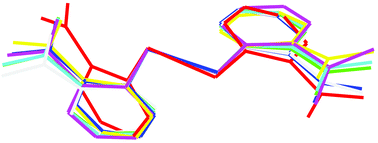The results of crystallographic analyses on a series of 1 ∶ 1 and 2 ∶ 1 co-crystals formed between 2,2′-dithiodibenzoic acid (DTBA) and each of 4,4′-bipyridine, trans-1,2-bis(4-pyridyl)ethene and 1,2-bis(4-pyridyl)ethane are described. Neutral molecules connected via O–H⋯N hydrogen-bonds leading to chains are found in the 1 ∶ 1 co-crystals. The intervention of a lattice water in a pseudo-polymorph of DTBA ∶ 1,2-bis(4-pyridyl)ethane consolidates chains into a 2-D array. Proton transfer occurs in the 2 ∶ 1 co-crystals so that the predominant motifs are chains of DTBA anions connected via charge-assisted O–H⋯O− interactions. In the co-crystal formed between 2(DTBA) ∶ 4,4′-bipyridine, characterised as a monohydrate, layers comprising DTBA anions are interspersed with layers of bipyridinium cations connected by water molecules. In the 2(DTBA) ∶ trans-1,2-bis(4-pyridyl)ethene and 2(DTBA) ∶ 1,2-bis(4-pyridyl)ethane co-crystals, the layers of DTBA anions are connected via O–H⋯O hydrogen-bonds and define columns in which are threaded chains of bipyridinium cations connected via N–H⋯N+ hydrogen-bonding. Finally, in the pseudopolymorph, 2(DTBA) ∶ 1,2-bis(4-pyridyl)ethane.EtOH, layers of anions are bridged by bipyridinium cations so that rectangular columns are defined and in which the solvent ethanol molecules reside.


 Please wait while we load your content...
Please wait while we load your content...